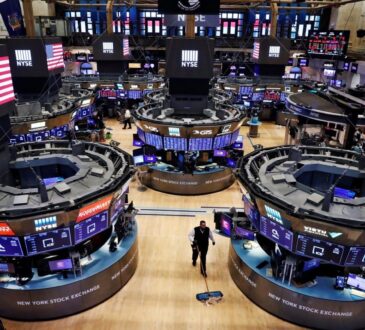
What was that? The environs around Wall Street, from New Jersey to the west to Long Island on eastward, were shaken on Friday morning, not from some market upheaval but the biggest earthquake in the region in some 140 years.
With a solar eclipse coming on Monday, more than a few wags were wondering if biblical plagues such as locusts and boils were likely to follow. And the conspiracy theorists probably were saying that Friday’s temblor—measuring 4.8, according to the U.S. Geological Survey—would have read higher were it not for fudge factors applied by government statisticians.
That couldn’t be claimed for the March employment data released a couple of hours earlier on Friday, which again showed much-larger-than-expected increases in payrolls but without the significant downward revisions of earlier data that undercut previous months’ reports. In addition, the unemployment rate dropped—and for the right reason, as more people entered the labor force and found jobs.
As for the numbers, nonfarm payrolls popped by 303,000 last month, roughly half again what economists had predicted, while the unemployment rate ticked down to 3.8% from 3.9% in February. Average hourly earnings increased 0.3% in March and were up 4.1% from a year earlier, while the workweek edged up one-tenth of an hour to 34.4 hours.
There were a few nits to be picked in the latest release, among them that the strong sectors were those that didn’t reflect the health of the economy, including government employment, up 71,000 in March, and healthcare, up 72,000. But construction jobs were up again, by 39,000, undeterred by higher interest rates.
One other knock on the labor market data has been the strength in part-time employment versus full-time jobs. But there’s nothing wrong with that, if it’s for the right reason, according to RBC Capital Markets economist Michael Reid. The number of part-timers who actually prefer those gigs outnumber those forced to take part-time work for economic reasons by a factor of five, he writes in a client note.
Advertisement – Scroll to Continue
With more employers changing work-from-home policies, it isn’t surprising that some workers are preferring more flexible arrangements, he continues. There is also a clear upward trend in the number of over-55 workers opting for part-time gigs instead of full-time, he adds.
In addition, while “prime age” (25 to 54) participation in the labor force has surpassed prepandemic levels, that hasn’t been the case for those older. The biggest shortfall has been among 65-plus workers; the absence of their experience and skills probably has contributed to weak productivity growth since 2021, according to Jefferies economist Thomas Simons.
In all, the March jobs report confirmed the picture of the U.S. economy growing at its potential—real gross domestic product expanding at a 2.5% annual rate in the first quarter, according to the GDPNow tracker from the Federal Reserve Bank of Atlanta—with the labor market at full employment but with inflation remaining significantly above the Fed’s 2% target.
Advertisement – Scroll to Continue
Fed Chair Jerome Powell nonetheless seems intent on the central bank lowering its key federal-funds policy rate, says Lara Rhame, chief U.S. economist at FS Investments. But she adds in an interview that the Fed might make “surgical, nip-and-tuck” cuts, as opposed to initiating a series of easing moves.
Powell’s dovish tone contrasted with other central-bank officials, notably Minneapolis Fed President Neel Kashkari, who helped shake markets on Thursday by suggesting that no rate cuts might be needed this year, a notion I discussed a week ago.
The most recent Summary of Economic Projections from last month’s policy meeting envisions a median of three reductions this year of one-quarter percentage point each, from the current fed-funds target range of 5.25% to 5.50%. After Friday’s robust jobs report, the futures market no longer looks for an initial cut in June, according to the CME FedWatch site, although it still prices in a total of three cuts by year end, if only barely.
Treasury yields moved up sharply on the week, with less probability of near-term Fed rate cuts and as oil and gold prices surged. The benchmark 10-year note ended the week at 4.38%, the highest yield since late November, and up over a 0.5 percentage point since early February. Stocks followed with the
Advertisement – Scroll to Continue
shedding 1%, despite a rebound of that much on Friday.
Perhaps even more important than the employment numbers will be inflation data to be reported this coming week. Closely watched will be the March consumer price index, due on April 9. The consensus guess among economists is for a 0.3% increase, down from 0.4% in February, both for overall and the “core” measure, excluding food and energy prices.
Gasoline prices probably lifted the headline number, but used-car prices are expected to show a sharp drop, according to Nomura economists. And they estimate that the so-called supercore measure (core services excluding rent) probably slowed to a 0.4% increase in March, from the average of 0.7% in the preceding two months.
Even with the improvement, the Nomura team thinks that inflation, as measured by the Fed’s preferred measure, the core personal consumption index, will remain well above its 2% target and the 2.6% median in the latest SEP. If that means fewer rate cuts than expected, watch out for more market tremors.
Write to Randall W. Forsyth at randall.forsyth@barrons.com




